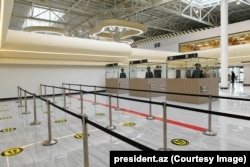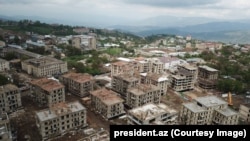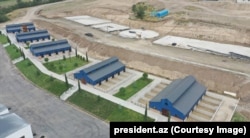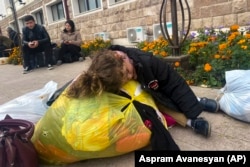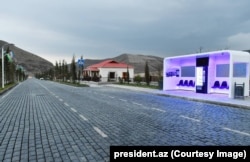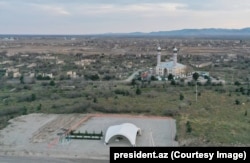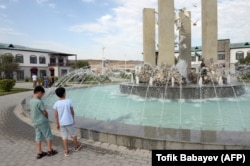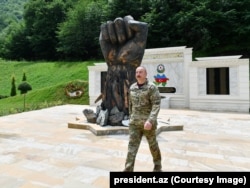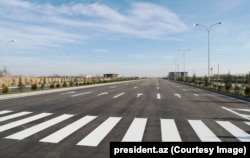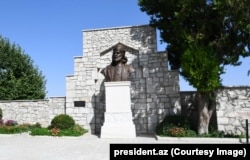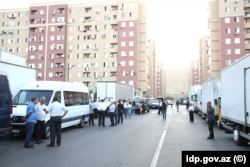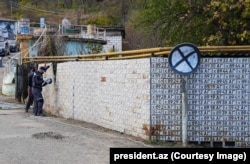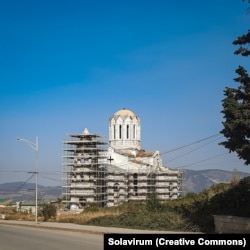Azerbaijan’s Fuzuli International airport bustled with journalists and minders on October 26, 2021, when President Ilham Aliyev opened the facility alongside his Turkish counterpart, Recep Tayyip Erdogan.
Since then, the new airport has stood largely empty.
A year after its opening, Azerbaijan reported around one plane arriving per week to the $44 million Fuzuli facility. Thus far in 2024, flight tracking websites show zero arrivals or departures.
Seventy kilometers northeast of Fuzuli, another sleek international airport was opened near Zangilan in October 2022. And in the mountains near Lachin, a third airport is under construction.
The airports are part of a massive construction drive in territory recaptured from ethnic Armenians following the Second Karabakh War launched by Baku in 2020, and Azerbaijan's final takeover of the breakaway region of Nagorno-Karabakh in September 2023.
Baku has touted the developments as part of a "great return to Azerbaijan’s liberated territories" for hundreds of thousands of Azerbaijanis who fled advancing Armenian forces in the 1988-94 war over Nagorno-Karabakh that was fought as the Soviet Union collapsed.
Azerbaijani economist Toghrul Valiyev told RFE/RL that the vast scale of the projects in the isolated regions may in part be due to various branches of the Azerbaijani state drumming up ideas to win easy funding.
"Every government agency is trying to take part in the distribution of billions of dollars of funds," Valiyev said.
Baku set aside $3.1 billion in 2023 for reconstruction in the recaptured areas.
As examples of what he describes as "creative" ideas for spending in the isolated regions, Valiyev says, "The Ministry of Agriculture comes up with a 'smart village,' even though the construction of cities and villages should be carried out by other bodies."
"AZAL (Azerbaijan Airlines) recommends the construction of the airport in Zangilan," the economist adds, "even though literally an hour’s drive in one direction (albeit in Armenia), and a couple of hours in the other direction, there are already airports."
Almost the entire ethnic Armenian population of Nagorno-Karabakh of around 100,000 people fled to Armenia in September 2023 after Baku launched a military offensive that brought the breakaway region under Azerbaijani control.
Nagorno-Karabakh is internationally recognized as part of Azerbaijan but was populated for centuries by ethnic Armenians.
Hikmet Hajiyev, an adviser to President Aliyev, claimed that Nagorno-Karabakh's ethnic Armenians left voluntarily, saying, "We opened the gate and respected their freedom of movement, freedom of choice."
But months of blockades of the region that preceded the military offensive -- and several alleged killings of ethnic Armenians who fell into the hands of Azerbaijani soldiers -- led to international legal experts viewing the exodus as an act of coercion that amounted to a war crime.
As of October 2023, only around 2,000 Azerbaijanis had returned to the empty regions. Baku said it aims to resettle some 150,000 people by 2027.
Armenian-American researcher Simon Maghakyan, who exposed Azerbaijan’s nearly complete destruction of Armenian Christian heritage in the exclave of Naxcivan, believes the massive construction projects may in some cases be being used as “cover for the ongoing erasure” of some of the thousands of Armenian historical sites in and around Nagorno-Karabakh.
In official photos released by Azerbaijan, Armenian cultural heritage is conspicuous in its absence.
Maghakyan, who has extensively researched open-source imagery of the recaptured regions, says “access to Nagorno-Karabakh appears to be tightly controlled, even for Azerbaijani tourists or former residents.”
Several Azerbaijani media members who recently visited the recaptured regions declined to comment to RFE/RL on what one described as “such a sensitive topic” in the wake of a wave of arrests of journalists in recent weeks.
In December 2021, the International Court of Justice (ICJ) made a provisional ruling that Azerbaijan needed to “punish and prevent” the destruction of Armenian monuments.
Before the ICJ’s 2021 provisional ruling, one of Nagorno-Karabakh’s most iconic buildings, the Ghazanchetsots Cathedral, had its spire shorn down to a byzantine-like dome after its capture by Azerbaijani forces.
Since the ICJ’s decision, observers say Baku appears to have been relatively restrained in its treatment of cultural sites, and there is some hope that the prominent Armenian cultural heritage that remains could survive if satellite monitoring and international pressure can continue.





